Oaxaca, Mexico.
Travel & Tour
Pictures, Photos, Information, Images, & Reviews.
George & Eve DeLange
Google Map To The Lambityeco Archaeological Ruins, Oaxaca, Mexico.
We Are Proud Of Our SafeSurf Rating!
Click On Any Of The Following Links By Amazon.Com
For Books Or Videos About Touring Lambityeco In Mexico. No Obligation!
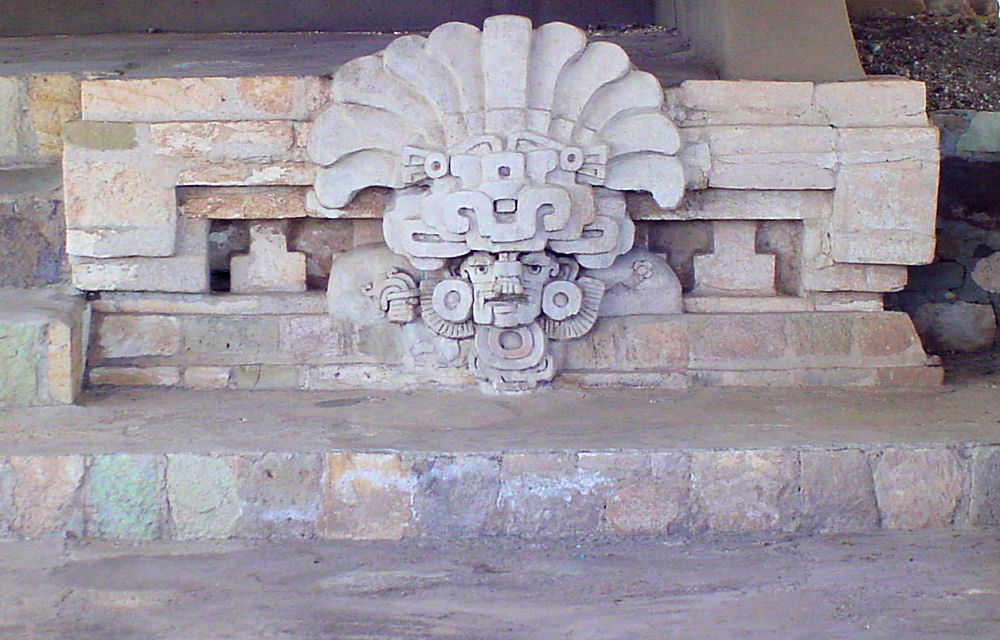
East Cocijo Mask. Lambityeco Archaeological Ruins, Oaxaca Mexico.
 |
| East Cocijo Mask. Lambityeco Archaeological Ruins, Oaxaca Mexico. |
|---|
Click On Any Of The Following Links By Amazon.Com
For Books Or Videos About The Zapotec People, In Mexico. No Obligation!
Lambityeco (lahm-beet-YE-ko), is a Zapotec name that translates as "Still" and "Mound". "Lambi" is the Zapotec version of the word alambique (still) which refers to the ovens where salty water is boiled. "Pityec" means "mound" in Zapotec. Lambityeco was also called Yeguih.
Evidence suggests that Lambityeco was first occupied about 600 B.C. Its zenith was being between 700 A.D. and 750 A.D. which coincides with the abandonment of Monte Alban. Lambityeco was considered to have important in the Zapotec trading system because of its production and trade in sea salt.
The buildings which have been discovered are very close to highway 190. The houses and palaces that have been discovered, make up a small part of the whole city and archaeologists are currently exploring other parts of Lambityeco further away from the road. To date approximately 63.75 hectares of this large side have been uncovered. This includes over 200 mounds of salt. No one knows how many more structures and salt mounds might actually be buried under the nearby town of Tlacolula.
The Palacio de los Caciques (Palace of the Political Leaders) and Palacio de los Sacerdotes (Palace of the Priests) are the oldest palaces that have been found at Lambityeco.
The Palace of the Caciques is located inside a pyramid. Its two patios are surrounded by four rooms. An altar in the center of these patios contains two murals of Lambityeco's rulers. The one on the north, known as "Sir 4 Human Face" and "Lady 10 Monkey", depicts both a reclining man with a pointed beard, wearing a maxtlatl and carrying a human femur in his hand, and a woman in the same position who wears earrings and necklaces, a quechquemitl, and whose hair is in a Zapotec style. This couple occupied the older palace between 600 and 625 DC. The mural on the southern wall is known as "Sir Owl" and "Lady Turquoise", who lived in the second palace between 625 and 650 DC.
The Palace of the Sacerdotes (Priests) is located behind pyramid M-195 and contains two stucco sculptures with two enormous busts of the Zapotec rain god, "Cocijo." The Zapotecs called this god Cocijo and the Mayas called him Chac. These two masks are equal in size and general shape, they are adorned with what appear to be crests of two large plumes with a central glyph with a stylized jaguar face. Each statue holds in its hands the forces of lightening and wind.
The entrance to Tomb No 6 is below the fresco on the altar. Its facade contains masks of "Sir I Earthquake" and "Lady 10 Cane", the last rulers of Lambityeco.
In the front of the ruins near the guard building is a Temazcal or steam bath. The floor of the steam bath is made of stone slabs. It has a stone channel built into the floor which passes out of the eastern wall of the structure. Water was poured into the channel. Steam was produced by placing very hot stones into the water in the channel. The Zapotecs used the steam for the purification of women after giving childbirth. This is the first steam bath found in the Oaxaca Area.
Palacio de los Racoqui. This is a pyramid platform of two main bodies which with two other low platforms create a quadrangular plaza with a central temple structure in front of a stairway. A residence of an important person (Coqui) was found in the upper part of the structure. It is the last of six superimposed palaces which were reconstructed and occupied by five or six generations of Nobles between 600- 750 A.D.
The Palacio de los Racoqui complex was used for both residentual and civic use. The residence was built on the M-195 sub platform and the plaza was for civic uses. The plaza could hold up to about 1500 people at one time. The temple in the center could have served as a platform from which the Coqui could speak. Tomb 1 was found under the floor of the palace and it contained fragmented bones which probably were the last Coqui to live in the palace.
The Templo de Cocijo is located on the west side of the patio and it has a central stairway which leads up to the patio. it's lateral walls are decorated with masks of the god Cocijo. The masks of Cocijo have topknots of long feathers attached with a glyph known as glyph C in the center. it also contains a stylized face of a jaguar. Each Cocijo carries the rays of lightening in one hand, symbols of his power. in the other hand he carries a flower vase shaped urn with water coming out showing his control over the water of Lambityeco.
The Xoxocotlán International airport (IATA: OAX, ICAO: MMOX) Is the international airport located at Oaxaca, Oaxaca, Mexico. It handles the national and international air traffic for the city of Oaxaca.
We have links on this page that will connect you with flights into and out of the Xoxocotlán International airport and allow you to book any of several of the best hotels in Oaxaca.
We suggest getting a hotel and then letting them arrange either a car or a tour of Oaxaca. If you call their Concierge Services ahead of your arrival, all of this can be pre-arranged for you.
We do this all the time, when traveling in Mexico. It is safe and it works!!! We have never experienced a problem, doing it this way!
We have placed links to Priceline.com on this page so you can arrange your flights into and out of Oaxaca; as well as your hotel, when visiting this area. We found that generally speaking, they provide the best hotel and air flight prices into Oaxaca.
Click On Any Of The Following Links By Amazon.Com
For Books Or Videos About Oaxaca Mexico. No Obligation!

Lambityeco With A Temazcal Or Steam Bath In Front. (east)
M 195 On The Right. Palacio de los Racoqui complex On The Left
Templo de Cocijo On Back (West) Of Left Side. Under Tin Roof.
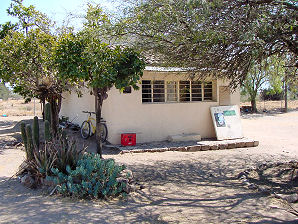

Guard House. Temazcal Or Steam Bath. 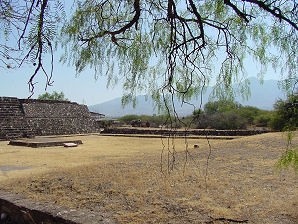
M-195 Pyramid And Courtyard. M-195 Pyramid And Courtyard. 
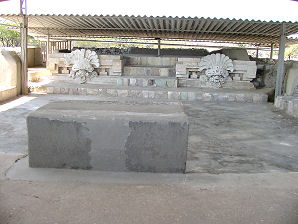
Palace of the Sacerdotes (Priests)
From South Looking North. Palace of the Sacerdotes (Priests)
Under The Tin Shed. 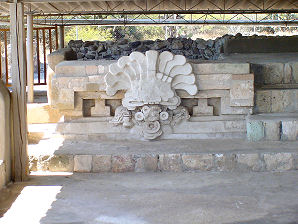
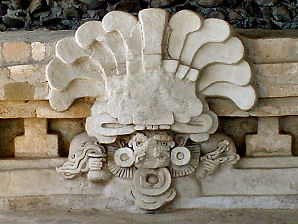
West Cocijo Mask. West Cocijo Mask Close Up. 

East Cocijo Mask. East Cocijo Mask Close Up. 
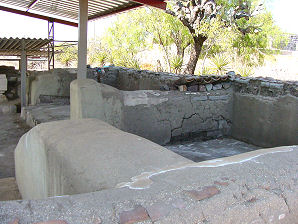
Palace of the Sacerdotes.
West Rooms. Palace of the Sacerdotes.
East Rooms. 

Tomb Two. Tomb 2. 
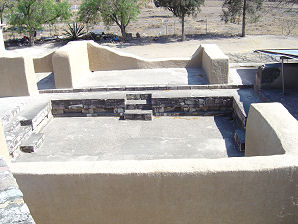
Lambityeco Archaeological Ruins Lambityeco Archaeological Ruins 
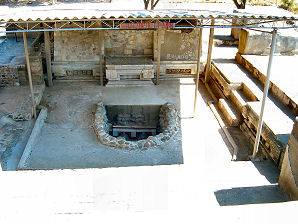
Palace Of The Caciques. Palace Of The Caciques. 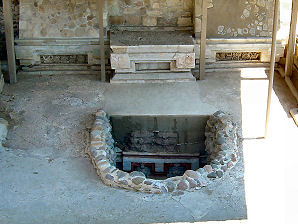
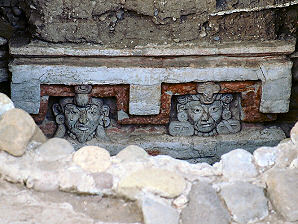
"Sir I Earthquake."
And "Lady 10 Cane."
The Last Rulers.
Of Lambityeco. "Sir I Earthquake."
And "Lady 10 Cane."
The Last Rulers.
Of Lambityeco. 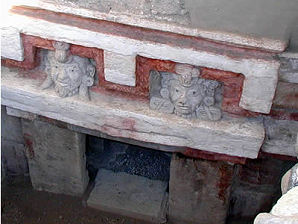
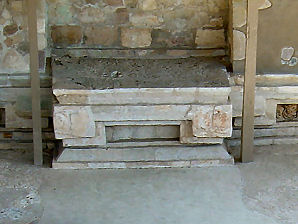
"Sir I Earthquake."
And "Lady 10 Cane."
The Last Rulers.
Of Lambityeco. Palace Of The
Caciques Throne. 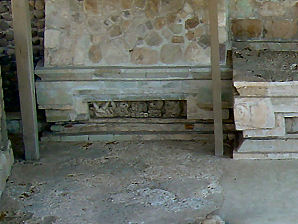
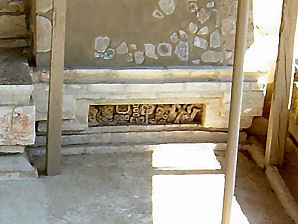
"Sir 4 Human Face."
And "Lady 10 Monkey." "Sir Owl" and "Lady Turquoise." 

Lambityeco Archaeological Ruins. Lambityeco Archaeological Ruins.
We Are Proud Of Our SafeSurf Rating!
Click On Any Of The Following Links By Amazon.Com
For Books Or Videos About Touring In Mexico. No Obligation!
Click On The Bottom Link Marked GO, Then Look At The Bottom Of The Page That Comes Up.
There You Will See Travel Agencies That Are Recommended By Amazon.Com
For Touring In Mexico. No Obligation!
Here Are Some Links To The Very Best & Most Popular Items Sold On Amazon.Com
To Learn More! Click The Links Below. No Obligation, Of Course!
Other Oaxaca Region Ruins & Attractions!
Lambityeco (lahm-beet-YE-ko), is a Zapotec name that translates as "Still" and "Mound". "Lambi" is the Zapotec version of the word alambique (still) which refers to the ovens where salty water is boiled. "Pityec" means "mound" in Zapotec. Lambityeco was also called Yeguih. Evidence suggests that Lambityeco was first occupied about 600 B.C. Its zenith was being between 700 A.D. and 750 A.D. which coincides with the abandonment of Monte Alban. Lambityeco was considered to have important in the Zapotec trading system because of its production and trade in sea salt. The buildings which have been discovered are very close to highway 190. The houses and palaces that have been discovered, make up a small part of the whole city and archaeologists are currently exploring other parts of Lambityeco further away from the road. To date approximately 63.75 hectares of this large side have been uncovered. This includes over 200 mounds of salt. No one knows how many more structures and salt mounds might actually be buried under the nearby town of Tlacolula. The Palacio de los Caciques (Palace of the Political Leaders) and Palacio de los Sacerdotes (Palace of the Priests) are the oldest palaces that have been found at Lambityeco. The Palace of the Caciques is located inside a pyramid. Its two patios are surrounded by four rooms. An altar in the center of these patios contains two murals of Lambityeco's rulers. The one on the north, known as "Sir 4 Human Face" and "Lady 10 Monkey", depicts both a reclining man with a pointed beard, wearing a maxtlatl and carrying a human femur in his hand, and a woman in the same position who wears earrings and necklaces, a quechquemitl, and whose hair is in a Zapotec style. This couple occupied the older palace between 600 and 625 DC. The mural on the southern wall is known as "Sir Owl" and "Lady Turquoise", who lived in the second palace between 625 and 650 DC. The Palace of the Sacerdotes (Priests) is located behind pyramid M-195 and contains two stucco sculptures with two enormous busts of the Zapotec rain god, "Cocijo." The Zapotecs called this god Cocijo and the Mayas called him Chac. These two masks are equal in size and general shape, they are adorned with what appear to be crests of two large plumes with a central glyph with a stylized jaguar face. Each statue holds in its hands the forces of lightening and wind. The entrance to Tomb No 6 is below the fresco on the altar. Its facade contains masks of "Sir I Earthquake" and "Lady 10 Cane", the last rulers of Lambityeco. In the front of the ruins near the guard building is a Temazcal or steam bath. The floor of the steam bath is made of stone slabs. It has a stone channel built into the floor which passes out of the eastern wall of the structure. Water was poured into the channel. Steam was produced by placing very hot stones into the water in the channel. The Zapotecs used the steam for the purification of women after giving childbirth. This is the first steam bath found in the Oaxaca Area. Palacio de los Racoqui. This is a pyramid platform of two main bodies which with two other low platforms create a quadrangular plaza with a central temple structure in front of a stairway. A residence of an important person (Coqui) was found in the upper part of the structure. It is the last of six superimposed palaces which were reconstructed and occupied by five or six generations of Nobles between 600- 750 A.D. The Palacio de los Racoqui complex was used for both residentual and civic use. The residence was built on the M-195 sub platform and the plaza was for civic uses. The plaza could hold up to about 1500 people at one time. The temple in the center could have served as a platform from which the Coqui could speak. Tomb 1 was found under the floor of the palace and it contained fragmented bones which probably were the last Coqui to live in the palace. The Templo de Cocijo is located on the west side of the patio and it has a central stairway which leads up to the patio. it's lateral walls are decorated with masks of the god Cocijo. The masks of Cocijo have topknots of long feathers attached with a glyph known as glyph C in the center. it also contains a stylized face of a jaguar. Each Cocijo carries the rays of lightening in one hand, symbols of his power. in the other hand he carries a flower vase shaped urn with water coming out showing his control over the water of Lambityeco.
|
The Xoxocotlán International airport (IATA: OAX, ICAO: MMOX) Is the international airport located at Oaxaca, Oaxaca, Mexico. It handles the national and international air traffic for the city of Oaxaca. We have links on this page that will connect you with flights into and out of the Xoxocotlán International airport and allow you to book any of several of the best hotels in Oaxaca. We suggest getting a hotel and then letting them arrange either a car or a tour of Oaxaca. If you call their Concierge Services ahead of your arrival, all of this can be pre-arranged for you. We do this all the time, when traveling in Mexico. It is safe and it works!!! We have never experienced a problem, doing it this way! We have placed links to Priceline.com on this page so you can arrange your flights into and out of Oaxaca; as well as your hotel, when visiting this area. We found that generally speaking, they provide the best hotel and air flight prices into Oaxaca.
|
Click On Any Of The Following Links By Amazon.Com
For Books Or Videos About Oaxaca Mexico. No Obligation!

Lambityeco With A Temazcal Or Steam Bath In Front. (east)
M 195 On The Right. Palacio de los Racoqui complex On The Left
Templo de Cocijo On Back (West) Of Left Side. Under Tin Roof.
 |
| Lambityeco With A Temazcal Or Steam Bath In Front. (east) M 195 On The Right. Palacio de los Racoqui complex On The Left Templo de Cocijo On Back (West) Of Left Side. Under Tin Roof. |
|---|
 |  |
| Guard House. | Temazcal Or Steam Bath. |
|---|---|
 | |
| M-195 Pyramid And Courtyard. | M-195 Pyramid And Courtyard. |
 |  |
| Palace of the Sacerdotes (Priests) From South Looking North. | Palace of the Sacerdotes (Priests) Under The Tin Shed. |
 |  |
| West Cocijo Mask. | West Cocijo Mask Close Up. |
 |  |
| East Cocijo Mask. | East Cocijo Mask Close Up. |
 |  |
| Palace of the Sacerdotes. West Rooms. | Palace of the Sacerdotes. East Rooms. |
 |  |
| Tomb Two. | Tomb 2. |
 |  |
| Lambityeco Archaeological Ruins | Lambityeco Archaeological Ruins |
 |  |
| Palace Of The Caciques. | Palace Of The Caciques. |
 |  |
| "Sir I Earthquake." And "Lady 10 Cane." The Last Rulers. Of Lambityeco. | "Sir I Earthquake." And "Lady 10 Cane." The Last Rulers. Of Lambityeco. |
 |  |
| "Sir I Earthquake." And "Lady 10 Cane." The Last Rulers. Of Lambityeco. | Palace Of The Caciques Throne. |
 |  |
| "Sir 4 Human Face." And "Lady 10 Monkey." | "Sir Owl" and "Lady Turquoise." |
 |  |
| Lambityeco Archaeological Ruins. | Lambityeco Archaeological Ruins. |
We Are Proud Of Our SafeSurf Rating!
Click On Any Of The Following Links By Amazon.Com
For Books Or Videos About Touring In Mexico. No Obligation!
Click On The Bottom Link Marked GO, Then Look At The Bottom Of The Page That Comes Up.
There You Will See Travel Agencies That Are Recommended By Amazon.Com
For Touring In Mexico. No Obligation!
Here Are Some Links To The Very Best & Most Popular Items Sold On Amazon.Com
To Learn More! Click The Links Below. No Obligation, Of Course!
Other Oaxaca Region Ruins & Attractions!
There You Will See Travel Agencies That Are Recommended By Amazon.Com
For Touring In Mexico. No Obligation!
Here Are Some Links To The Very Best & Most Popular Items Sold On Amazon.Com
To Learn More! Click The Links Below. No Obligation, Of Course!
Other Oaxaca Region Ruins & Attractions!



